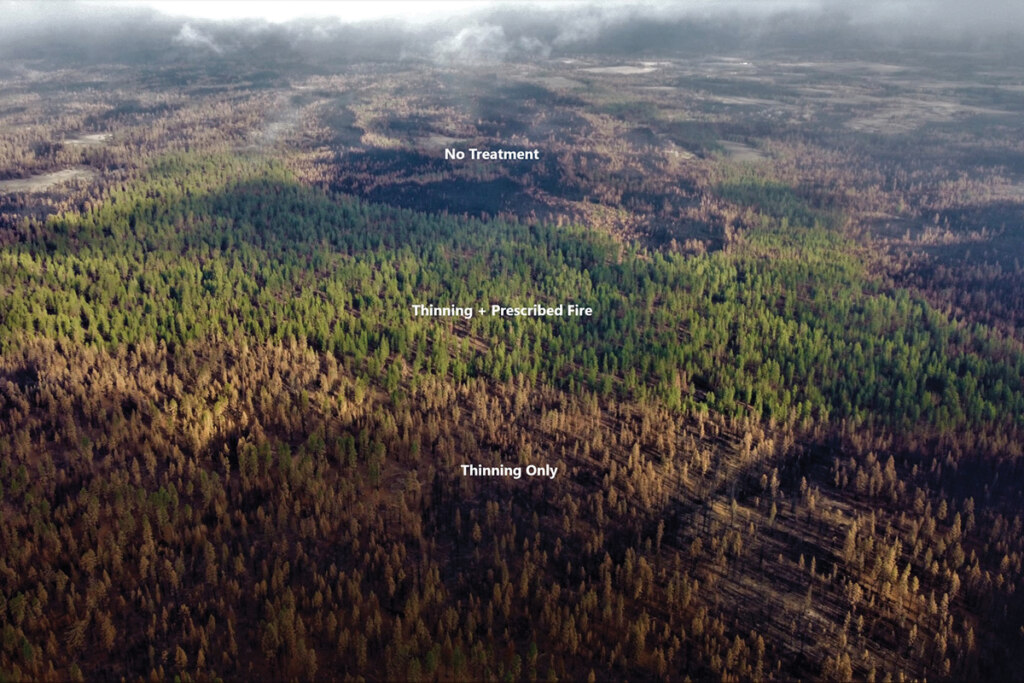The Role of Forest Restoration
"With proactive efforts to restore our forests, we can begin to tackle the wildfire crisis."
This past weekend while trying to beat the heat on the water with my family, the ominous thrum of a helicopter passed above our heads. A Chinook helicopter with a dangling water bucket flew over, followed closely by two scooper planes on an aerial firefighting mission. A telltale sign that wildfire season is igniting in Montana.
Wildfires are burning larger and more destructive than they did in previous decades, and it’s worth asking why so that forest managers can better address the growing wildfire risk. Fires have burned an area larger than the state of Arizona over the past decade. While the number of wildfires in the United States has not increased, the total acres burned has grown in recent years and each fire burns more land on average than in 1985. Last year alone, federal agencies spent more than $3.5 billion trying to put out wildfires.
Beyond destroying thousands of homes and threatening human lives, wildfires have a terrible environmental impact. Wildfires jeopardize wildlife habitat and watersheds and have killed up to a fifth of the world’s remaining giant sequoia trees in recent years. Wildfire smoke is also the largest single source of PM2.5 emissions, yet the Environmental Protection Agency routinely treats wildfires as exceptional events and excludes them from air quality standards.
Fires release massive quantities of greenhouse gasses, including 112 million tons of carbon dioxide in California in 2020—the equivalent of adding more than 24 million cars to the state’s roads. The emissions from wildfire in just that one year was double the amount of carbon dioxide reductions achieved by the state since 2003.
As with any complex phenomenon, no single factor fully explains declining forest health or the wildfire crisis. A changing climate has increased the risk of drought and extended the West’s “wildfire season.” A massive jump in the number of people living near or recreating in forests has increased opportunities for human-caused ignitions. But the largest factor, according to a study by Forest Service scientists, is excessive forest density and the buildup of fuels due to decades of failed fire suppression policies. The study found that among the four factors driving fire severity in the western United States, live fuel accounted for an estimated 53.1 percent of average relative influence, fire weather accounted for 22.9 percent, climate accounted for 13.7 percent and topography accounted for 10.3 percent.
According to the Forest Service, forty percent of the acres in the national forest system are in need of restoration to address excess fuels, invasive species, disease and insect infestations, and other conservation challenges. When the Department of the Interior’s 54 million acre restoration backlog is added in, the total area needing urgent help is larger than the state of California. The wildfire crisis is the most visible symptom of this problem but it is not the only one. Due to the backlog, many western forests are stocked full with overly dense, unhealthy, and dying stands that provide lower quality habitat, are more vulnerable to insects and disease, and are less resilient to climate change and drought.
Forest restoration can reverse these trends and promote healthier, more resilient forests. Restoration activities can involve mechanical thinning and prescribed burning to mitigate immediate wildfire risks by reducing forest density and removing overgrown brush. It can also involve replanting native trees, removing invasive plants, and addressing erosion risks to help forests recover from fire. Different forests in different locations under different conditions will require unique combinations of these management tools.

© S. Rondeau/Klamath Tribes’ Natural Resource Department
The effectiveness of mechanical treatments and prescribed burns was demonstrated in 2021 during Oregon’s Bootleg Fire, which ultimately burned more than 400,000 acres. Katie Sauerbrey, a fire manager for The Nature Conservancy, told The New York Times that it was “the most extreme fire behavior I had ever seen in my career.” But when the fire moved from the Fremont-Winema National Forest to The Nature Conservancy’s privately owned Sycan Marsh Preserve that had been thinned and burned, the fire’s behavior changed dramatically. Firefighters reported that where both mechanical thinning and prescribed fire treatments had been applied, fire intensity was reduced, the crowns of trees were left intact, and the blaze became a more manageable ground fire.
These and other high-profile examples of forest restoration projects reducing the consequences of wildfires have sparked bipartisan interest in ramping up those projects. Last year, the U.S. Forest Service announced a 10-year strategy to implement strategic restoration projects—including mechanical thinning and prescribed burns—on 50 million acres (over and above its normal restoration levels) of federal, state, and private land where fire risks and threats to communities are greatest. This ambitious plan relies on roughly $5 billion that Congress has appropriated for wildfire risk reduction, and it calls for spending a total of $50 billion over the next decade.
But carrying out the Forest Service’s ambitious plan in a mere decade will require more than increased funding. It will require Congress and the Forest Service to address policy obstacles that have sapped the agency’s ability to deliver forest restoration at scale and on time. And it will also require greater engagement with states, tribes, and private partners to capitalize on their local knowledge and capacity to perform restoration projects. With proactive efforts to restore our forests, we can begin to tackle the wildfire crisis.
Hannah Downey is the policy director at PERC (the Property and Environment Research Center) in Bozeman.
